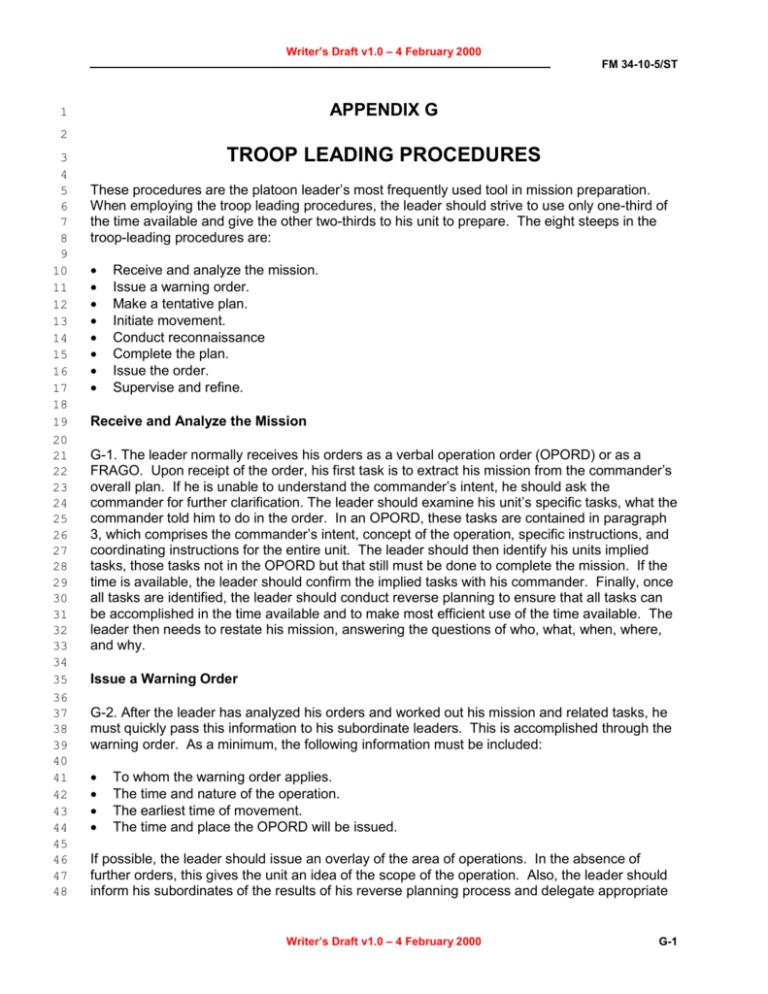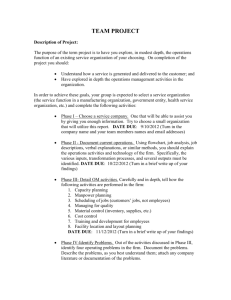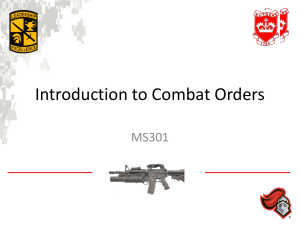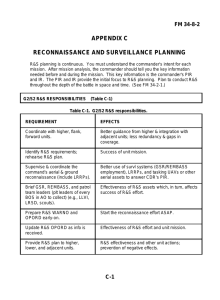troop leading procedures
advertisement

Writer’s Draft v1.0 – 4 February 2000 FM 34-10-5/ST APPENDIX G 1 2 3 4 5 6 7 8 9 10 11 12 13 14 15 16 17 18 19 20 21 22 23 24 25 26 27 28 29 30 31 32 33 34 35 36 37 38 39 40 41 42 43 44 45 46 47 48 TROOP LEADING PROCEDURES These procedures are the platoon leader’s most frequently used tool in mission preparation. When employing the troop leading procedures, the leader should strive to use only one-third of the time available and give the other two-thirds to his unit to prepare. The eight steeps in the troop-leading procedures are: Receive and analyze the mission. Issue a warning order. Make a tentative plan. Initiate movement. Conduct reconnaissance Complete the plan. Issue the order. Supervise and refine. Receive and Analyze the Mission G-1. The leader normally receives his orders as a verbal operation order (OPORD) or as a FRAGO. Upon receipt of the order, his first task is to extract his mission from the commander’s overall plan. If he is unable to understand the commander’s intent, he should ask the commander for further clarification. The leader should examine his unit’s specific tasks, what the commander told him to do in the order. In an OPORD, these tasks are contained in paragraph 3, which comprises the commander’s intent, concept of the operation, specific instructions, and coordinating instructions for the entire unit. The leader should then identify his units implied tasks, those tasks not in the OPORD but that still must be done to complete the mission. If the time is available, the leader should confirm the implied tasks with his commander. Finally, once all tasks are identified, the leader should conduct reverse planning to ensure that all tasks can be accomplished in the time available and to make most efficient use of the time available. The leader then needs to restate his mission, answering the questions of who, what, when, where, and why. Issue a Warning Order G-2. After the leader has analyzed his orders and worked out his mission and related tasks, he must quickly pass this information to his subordinate leaders. This is accomplished through the warning order. As a minimum, the following information must be included: To whom the warning order applies. The time and nature of the operation. The earliest time of movement. The time and place the OPORD will be issued. If possible, the leader should issue an overlay of the area of operations. In the absence of further orders, this gives the unit an idea of the scope of the operation. Also, the leader should inform his subordinates of the results of his reverse planning process and delegate appropriate Writer’s Draft v1.0 – 4 February 2000 G-1 FM 34-10-5/ST Writer’s Draft v1.0 – 4 February 2000 49 50 51 52 53 54 55 56 57 58 59 60 61 62 63 64 65 66 67 68 69 70 71 72 73 74 75 76 77 78 79 80 81 82 83 84 85 86 87 88 89 90 91 92 93 94 95 96 97 preparatory tasks to his NCOIC and subordinate leaders. If possible, the leader should include task organization. The reverse planning schedule, in addition to accounting for all required preparatory tasks, should include a sleep plan. All elements should acknowledge receipt of the warning order. Make a Tentative Plan G-3. Once the warning order is issued, the leader must determine how he will accomplish his mission. He puts the tasks identified when he received his order into battle sequence, the order in which he expects to meet each task. Working with the factors of METT-TC, he makes a tentative plan for ultimate mission accomplishment. The leader does not necessarily perform an IPB, although he may have received IPB products along with his order. He should incorporate this information into his METT-TC analysis and use it in developing one or more courses of action. He must choose the best course of action based on the advantages and disadvantages of each course. Initiate Movement G-4. After issuing a warning order and making a tentative plan, the leader may choose to initiate movement. He may send a quartering party out to a new assembly area, or he may move his whole unit. Whatever the case, the leader should at least be able to determine when the platoon will move. He announces this in terms of a readiness condition. Conduct Reconnaissance G-5. This step of the troop-leading procedures allows the leader to confirm the validity of his tentative plan. He should at least confirm his initial march route to the LD or start point (SP) and check initial positions. If possible, he should also check some of the area beyond the LD, taking his subordinate leaders with him so they too can see the ground. This may require permission of the commander. If the leader can not go personally, he should task his subordinates to accomplish specific requirements to most efficiently use the available time. The leader must conduct the reconnaissance with an open mind; not everything he sees will match his tentative plan. He must be flexible enough to change and competent enough to work out new plan swiftly. The leader ensures all reconnaissance is authorized by his higher headquarters. Complete the Plan G-6. The leader should be able to bring the tentative plan close to completion after his reconnaissance. He should continue to refine the plan based on new information from his parent unit commander, other leaders, or his own troops. Issue the Order G-7. The order should be issued to all the subordinate leaders. Once everyone has arrived at the place and time indicated in the warning order, the leader should set up his vehicle commanders in the order in which they will maneuver. To ensure everyone has the graphic control measures he will refer to, he should issue the revised operations overlay before he starts. He provides a copy of the graphics to each of his subordinate leaders. To use his time G-2 Writer’s Draft v1.0 – 4 February 2000 Writer’s Draft v1.0 – 4 February 2000 FM 34-10-5/ST 98 99 100 101 102 103 104 105 106 107 108 109 110 111 112 113 114 115 116 117 118 119 120 121 122 123 124 125 126 127 128 129 130 131 132 133 134 135 136 137 138 139 140 141 142 143 144 145 146 efficiently, the leader should use a walk-through rehearsal as part of his briefing of paragraph 3 of the order. G-8. If the order can be issued from a vantage point, the leader can physically indicate the ground his subordinates will maneuver across. If a vantage point is not available, a terrain cloth, sand table, or map may be used. The leader should have a briefing kit available to build a model for his briefing. The kit might include the following items: Chalk. Colored sand. 3 by 5 inch index cards. Micro vehicles or other models. Yarn or string. Pens and markers. Stakes. Engineer tape. Operational symbol cutouts. G-9. The leader issues his finalized order in the five paragraph OPORD format. He refers to notes while giving his orders to make sure he does not forget anything. He ensures that subordinate leaders understand the entire plan as well as their particular portion of it. When time permits, the leader should war-game the operation with his leaders. To ensure complete understanding of the operation, he should end the order with a back-brief of key points by his subordinate leaders. Supervise and Refine G-10. The leader and NCOIC make sure all members have been briefed by their leaders and understand the mission and concept of the operation. Subordinate leader briefings and rehearsals are essential to a successful operation. The leader ensures the entire unit chain of command conducts pre-combat checks and procedures in accordance with the unit SOP. The leader and NCOIC observe each crew during pre-combat checks. They should conduct an inspection once the subordinate leaders report that there are prepared. Flexibility is the key to effective operations. The leader must be able to refine his plan as new information become available. If he adjusts his plan, he must inform his unit. Once the operation has begun, the leader must be able to adapt quickly to new situations and new orders. G-11. When there is not enough time to conduct all eight steps in detail, the leader must understand how to trim them to save time. Most troop-leading procedures can be done mentally. Once the order is received, the leader conducts a quick map reconnaissance and analysis, then sends for his subordinate leaders. He makes sure they post the minimum required control measures on their maps and gives an abbreviated order consisting of a quick threat and friendly situation, the unit mission, and the concept of the operation. The service support and signal paragraphs can be deleted if covered by unit SOP. The abbreviated order should not be the usual technique used by the unit; it is a technique to use only when time is short. G-12. When time is available, however, there is no substitute for effective preparatory instructions, a thorough tactical plan, and a formal OPORD. The odds of success increase Writer’s Draft v1.0 – 4 February 2000 G-3 FM 34-10-5/ST Writer’s Draft v1.0 – 4 February 2000 147 148 considerably when detailed planning and rehearsal are used prior to an operation, even when time is short. Successful leaders make the most of every available minute. G-4 Writer’s Draft v1.0 – 4 February 2000







